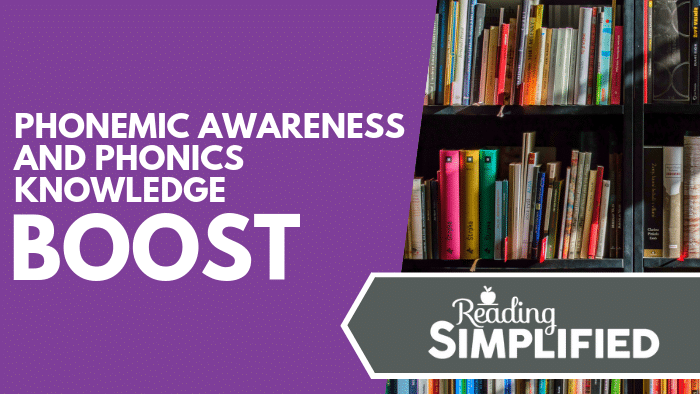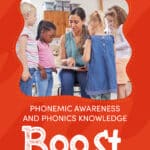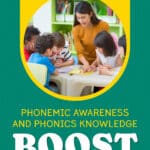
Researchers have noticed that teachers across the board (and the world) from pre-service teachers to highly experienced teachers lack knowledge in fundamental early reading skills about things like phonemic awareness and phonics knowledge.
Most of these teachers don’t even realize they lack in this area. But if they were to get a little booster (say, around an hour and a half of information), their teaching would improve, and their students would perform better too.
Here’s a little slice of knowledge for you…
Good teachers have good pedagogical content knowledge (that’s a mouthful, right?)
But what does this mean, I hear you ask?
Well, it’s essentially the specialized knowledge and skilled teaching of a particular subject. In this case, the “content knowledge” refers to reading. It’s worth noting that just because you’re a good reader, it doesn’t necessarily mean you’re good at pedagogical (instructional) content knowledge to help improve student outcomes and help them learn the code.
So, if you think this is an area you as a teacher may need some work on, you’ve come to the right place!
{To watch a video where I discuss this topic hit play below, or read on for a detailed overview}
In this article, I give you a little booster so that you can improve the quality of your teaching and help to increase your student’s achievement.
Why is Pedagogical Content Knowledge so important?
Pedagogical content knowledge is so important for teaching kids to read because a student’s outcome directly depends on the quality of teaching they receive.
How can you expect a child to understand letter names, letter-sounds, and phonemes if you aren’t 100% sure on those areas yourself.

Let’s put our thinking caps on for a moment and imagine the following situation:
Your student is attempting to read the word “MILK.”
They give it their best shot but instead of saying “MILK,” they say “MIK,” and then they try to correct themselves with the word “MIKE.”
If you’re a good reading teacher and you’ve got pedagogical content knowledge, you need to know the different steps the student went through to make that error, so you know what to address.
The first error occurred when they tried to read “MILK” but came out with “MIK” instead.
What caused the student to make that mistake?
Well, they probably don’t have the phonemic processing to include the “LK” sounds at the end. You, as the teacher, must know that the adjacent consonants are difficult to blend, so that’s likely to be what caused the student to drop the “L” and go with “MIK” instead of “MILK.”
But what about the second error?
How did the student end up with the word “MIKE”? There isn’t any “e’s” in milk!
Well, it was most likely because they switched it to a word they DO know, and they ended up switching the vowel to get MIKE. The root of their problem lies with their struggle with phonemic blending. As a reading teacher, you need to know how to help them overcome their difficulties.
So, you might encourage them to try again by using the Blend as you Read Strategy (you can find out more about this strategy here) and cover up the last sound and ask them to blend the first three sounds before revealing the “K” and hopefully they’ll get “MILK.”
Key Takeaway – The student went through multiple steps, so the teacher needs to go through multiple steps too! This is how you can be a wise intervener and provide proper feedback. Everything the teacher is doing in the context of that one little error is pedagogical content knowledge.
Remember, you’ve got to know the necessary content knowledge and identify the issue. One of the fundamental problems I see time and time again in the teaching profession is that many teachers don’t have good foundation of content knowledge with phonemic awareness and phonics.
Critical Early Features for the Teaching of Reading
The following is pretty basic, but let’s make sure we’ve got it covered!
Here are the vital early features for the teaching kids how to read:
1. Letter Names
2. Letter Sounds
3. Phonemes (individual speech sounds)
It’s also worth noting the difference between Phonemic Awareness and Phonological Awareness:
• Phonemic Awareness is the perception of individual phonemes
• Phonological Awareness is more global and means to perceive any sounds/words.
We also need to understand the difference between phonics regularity and phonics irregularity. In other words, the patterns that are repeatable and predictable Vs. things that “pop up” in our language that are more irregular and don’t follow the main pattern.
Let’s take a look at a quick example of this…
The vowel sound /o/ in HOME and NOTE follows the phonics regularity pattern where the O is separated from E and sounds like the normal /o/ sound.
But…if we take a word like DONE or GONE, the /o/ sound changes because it doesn’t follow the regular pattern. Instead, the phonics is irregular and not what you expect. So, you’ve got to know the difference and be able to relay this information to your students in a way they can understand and replicate.
Thinking of Phonemic Difficulty
Here’s an easy way to think about phonemic difficulty:
CVC – CVCC – CCVC – CCVCC – CCCVCC
As you can see, CVC words are the easiest words phonemically. They have three sounds (consonant, vowel, consonant, i.e. CVC). CVC words like HOT are easy to segment, blend and manipulate. A word like HOT can easily become HIT or HAT, for example.
CVCC is slightly more difficult with two consonants at the end of the word such as MILK. If we take a step further to CCVC, we tackle more difficult four-sound words with adjacent consonants at the beginning such as STOP.
The level of difficulty increases as you move along the continuum. CCVCC words have five-sounds, which is even harder to blend and segment. The most phonemically difficult is the CCCVCC words that have six sounds such as STRAND.
Understanding the Basic Code Vs. Advanced Code
As reading teachers, it’s vital that we consider the code. Phonics can be tricky, so I suggest you think about the basic code and advanced code separately.
The basic code includes things like consonants, short vowels and consonant digraphs (such as CH or TH). They make up the basic code because they are very predictable and rarely change. Words in the basic code are easier for beginner readers because there aren’t a lot of variables.
The advanced code is more difficult and includes things like long vowels because they can have more than one spelling. One spelling can have more than one sound, which is more challenging for our kiddos to “get.”
If you want to find out more about how you can improve your pedagogical content knowledge, check out this blog post where you’ll be challenged to test your phonemic awareness and phonics knowledge!




I just want to appreciate you for your thoughtful content-its so easy to read and understand. I aspire to one day follow in your foot-steps and become a qualified Reading Specialist; so in the meantime whilst i accumulate some funds i am enjoying your content,priming me up for when i begin my course. However i’m not quite decided on which Program to affiliate myself with…i’d really apreciate any suggestions from you.
Thank you very much
Beverly (Gaborone,Botswana)
Thanks for your interest! If you become a member of the Reading Simplified Academy you will learn a streamlined system for teaching anyone how to read. Here’s more about that program: ReadingSimplified.com/academy